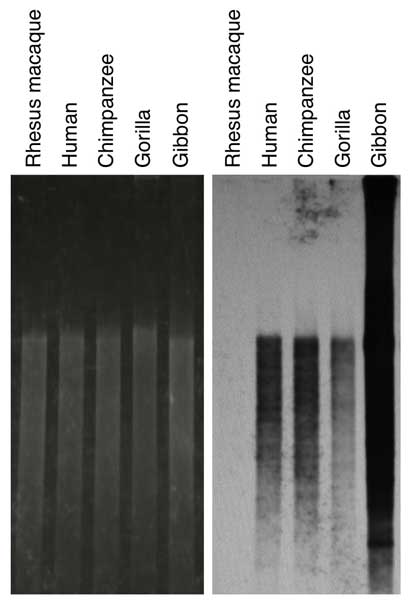Tandem repeat sequences evolutionarily related to SVA-type retrotransposons are expanded in the centromere region of the western hoolock gibbon, a small ape原暢・平井百合子・イスラト ジャハン・平井啓久・古賀章彦 【背景】フーロックテナガサルでトランスポゾン(動く遺伝子)に関連する反復配列が増加していることが、比較ゲノムハイブリダイゼーションの結果から示唆された。 【目的】この反復配列の実態を明らかにし、また増殖の過程を推測し、トランスポゾンのゲノムへの影響を検討する。
【結果】この反復配列は、フーロックテナガサルのセントロメアで大規模に増幅している。長さは 40 kb を超える。塩基配列は、SVA 因子とよばれるレトロトランスポゾンの内部にある反復配列と、同じであった。
【意義】SVA 因子または類似の因子がセントロメアに転移で入り込み、セントロメアが本来もつ性質のために反復配列が大規模に伸張したものと推測される。セントロメアの成分の内訳を大きく変えるほどの規模である。SVA 因子および類似の因子は、ヒトのゲノムにも多数のコピーがあるため、同様の現象はヒトでも起こりえるといえる。 Journal of Human Genetics, doi:10.1038/jhg.2012.107. 
Hoolock hoolock (the western hoolock gibbon) is a species of the family Hylobatidae (small apes), which constitutes the superfamily Hominoidea (hominoids) together with Hominidae (great apes and human). Here, we report that centromeres or their vicinities in this gibbon species contain tandem repeat sequences that consist of 35–50-bp repeat units, and exhibit a sequence similarity with the variable number of tandem repeat (VNTR) region of the SVA, LAVA and PVA transposons. SVA is a composite retrotransposon thought to have been formed by fusion of three solo elements in the common ancestor of hominoids. LAVA and PVA are recently identified retrotransposons that have the same basic structure as SVA. Thus, the large-scale tandem repeats in the centromere region may have been derived from one or more of SVA-type transposons, including the three mentioned above and other yet unknown elements, or the repeat sequences could have served as a source for such elements. Amplification of VNTR-related sequences in another gibbon species,
Hoolock leuconedys (eastern hoolock gibbon), has recently been reported, but it is yet to be examined whether the large-scale tandem repeats observed in the two species originated from a single event that occurred in their common ancestor. The repeat sequences in the western hoolock gibbon are mostly 40 kb or more in length, are present in 28 of the 38 chromosomes of the somatic cells, and are homozygous for chromosomal presence/absence. AUG/31/2012
Copyright(C) 2012 PRI ( ). ).
| 






